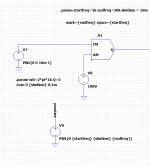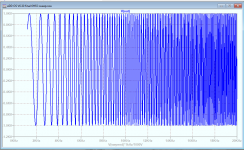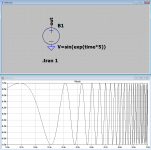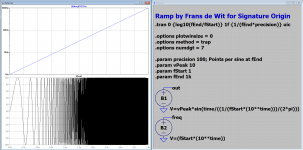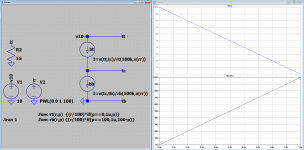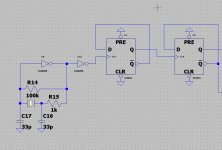Hi Ian, yes I did something similar, but don't know how to get 'kHz' on the X-axis instead of 'kV'. Not critical, but would be nice ;-)
I also changed the FM input source to a PWL wave; using a Pulse here feels a bit awkward.
I'm setting the X-axis to V(swpend)*1kHz/1000V and it will show the frequency correctly.
Jan
I also changed the FM input source to a PWL wave; using a Pulse here feels a bit awkward.
I'm setting the X-axis to V(swpend)*1kHz/1000V and it will show the frequency correctly.
Jan
Attachments
Last edited:
I'm setting the X-axis to V(swpend)*1kHz/1000V and it will show the frequency correctly.
What a clever way to convince LTSPICE's axis labeling "automatic detection of units" code, that your axis is hertz instead of volts. Congratulations!!
Actually, I got idea after reading Ian's post above. But yes, it's nice to see it all come together!
Jan
Jan
Hello all guys.
Is there a way to simulate a potentiometer (not rheostat)?
How do I simulate a log pot?
Many thanks in advance.
Is there a way to simulate a potentiometer (not rheostat)?
How do I simulate a log pot?
Many thanks in advance.
Here is a potentiometer, can be used with constants, or stepped, or voltage controlled as here.
v10 = psu
rr = potentiometer percentage as a voltage 0...100%
rt() formula for resistor at top
rb() formula for resistor at bottom
the formula input parameters are r=resistance, p=percentage
bt = resistor at top
bb = resistor at bottom
the resistors are created by using a current source, where i=v/r
tt, tc and tb are trimmer top, center and bottom
Have fun,
Just remember, Ohm's law solves most of your problems
p.s. the if(...) statement in .func rt(r,p) {(r/100)*if(p==0,1u,p)}
and .func rb(r,p) {(r/100)*if(p==100,1u,100-p)}
prevents zero Ohm as a value by substituting it (zero) with 1u
v10 = psu
rr = potentiometer percentage as a voltage 0...100%
rt() formula for resistor at top
rb() formula for resistor at bottom
the formula input parameters are r=resistance, p=percentage
bt = resistor at top
bb = resistor at bottom
the resistors are created by using a current source, where i=v/r
tt, tc and tb are trimmer top, center and bottom
Have fun,
Just remember, Ohm's law solves most of your problems
p.s. the if(...) statement in .func rt(r,p) {(r/100)*if(p==0,1u,p)}
and .func rb(r,p) {(r/100)*if(p==100,1u,100-p)}
prevents zero Ohm as a value by substituting it (zero) with 1u
Attachments
Last edited:
Your graph clearly shows a LINEAR transition, not a LOG one.Here is a potentiometer, can be used with constants, or stepped, or voltage controlled as here
Here's a better transition.
But I cannot get LTspice to plot R (rotation %) versus voltage out. ????? Suggestions?
But I cannot get LTspice to plot R (rotation %) versus voltage out. ????? Suggestions?
Attachments
Last edited:
What if none of the extremes of the resistance nor the wiper is grounded? What I want to simulte is a Baxandall active tone stack. In these cases no grounded pin is available.
Last edited:
- Home
- Design & Build
- Software Tools
- Installing and using LTspice IV (now including LTXVII), From beginner to advanced
